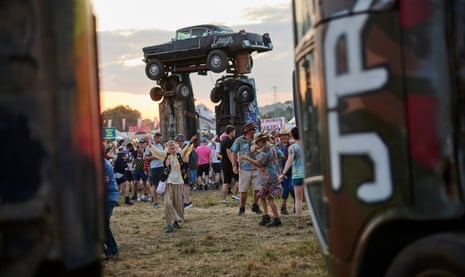
When the artist Joe Rush first built Carhenge at Glastonbury in 1987 – as the name suggests, it’s Stonehenge recreated with scrap-metal cars – the political conditions were rather different to the ones under which it has been rebuilt at the festival this year.
“36 years ago we were much younger and they were very wild times. It was more extreme than it is now,” Rush says. “Police were attacking us all the time; things were much more unofficial. It was an alternative culture.”
The original Carhenge was built in the aftermath of the Battle of the Beanfield in 1985. Several hundred new age travellers were prevented from attending the Stonehenge Free festival by Wiltshire police, resulting in dozens of travellers being injured as well as over 500 arrested, becoming one of the largest mass arrests of civilians since the second world war.

Following the incident, Rush – the founder of Mutoid Waste Company, an artist collective which produces installations out of forms of waste – decided to take action.
“We decided that if we weren’t allowed to go to Stonehenge, that we would build Stonehenge where we were. And because we worked with waste, the obvious thing to use were cars as the objects to represent the stones.”

The sculpture has been reinstalled by Rush and his team, created from 24 mutated vintage cars, with each vehicle serving as a tribute to the “nonconformists, punks, trailblazers and revolutionary visionaries who have shaped underground culture”, including Quentin Crisp, Vivienne Westwood and Chuck Berry.
Creating the original Carhenge was certainly much more haphazard than creating the replica. “In 1987, we arrived in our chopped-up illegal trucks,” Rush says. “It was quite difficult to do a build in those days – we had one little crane that we used and banged a couple of scaffolding poles into the ground and welded the cars on to it.

“In some ways it was much easier because there were no real health and safety. But it was much more difficult in other ways because we didn’t have all the equipment that we have nowadays. So it was a very different world.”
Carhenge’s return to this year’s festival is particularly special, given that it will coincide with the summer solstice, an event with particular significance to pagans and travellers who travel to the Stonehenge site to commemorate the day.
“It’s quite extraordinary, because usually Glastonbury is a week after the solstice,” Rush says. As well as the installations, the solstice will be marked by a performance from Fulu Miziki, a group of Congolese musicians who create sound from waste.

Despite the difference in generations under which both henges were built, for Rush, the installations represent similar ideals. “The sculpture represents the ideas around Stonehenge and the alternative movement, which again represent lots of the very early periods the ideas of organic food, wind generation, solar generation,” Rush says. “These are all ideas that grew out of the hippie movement, the free festival movement and the punk movement [and] have now been included in mainstream society and make up the fabric of what we know as a society. It represents a whole evolution of this culture.”
For the first time, Carhenge and six more major Rush installations will be shown at the same time across the festival site. In the centre of Carhenge stands a tree made of exhaust pipes – first created as a tribute to Rush’s friend, late Clash frontman Joe Strummer – that acts as a rebuke to the environmental damage wreaked by the internal combustion engine.

Rush has been instrumental in the construction of various other attractions and stages across the festival over the years, including the Unfairground, the peace sign on the Pyramid Stage, and Glastonbury-on-Sea.
For the latter, the idea was inspired from Rush’s childhood, having grown up with a father who worked as a portrait sketcher on Hastings beach. “I was just having a conversation with my wife and we thought what if we actually built the pier on dry land,” Rush says. “I went to see Mike Eavis and said I wanted to build a pier, and the first thing he asked was: will it have Punch and Judy? I said yes. And he said, right, we’ll do it.”
Another Rush installation will be seen on the Other stage: three reptile eyes erected on to a platform, to remind humans of our obligation to protect the natural world. “The idea behind that was really to just make people think that all these creatures are watching us human beings, and seeing what we’re going to do, because we basically control their existence,” Rush says.

Ultimately, Rush hopes that the new installation of Carhenge can unite generations born decades apart, and that it “becomes an important part of their life where amazing things happen”. For him, it can hopefully mirror the energy of Stonehenge itself, somewhere that’s “not a rave or a stage, it’s a place where the star is the sculptural installation. Stonehenge has always meant to be a gathering of the people”.










 English (US)
English (US)